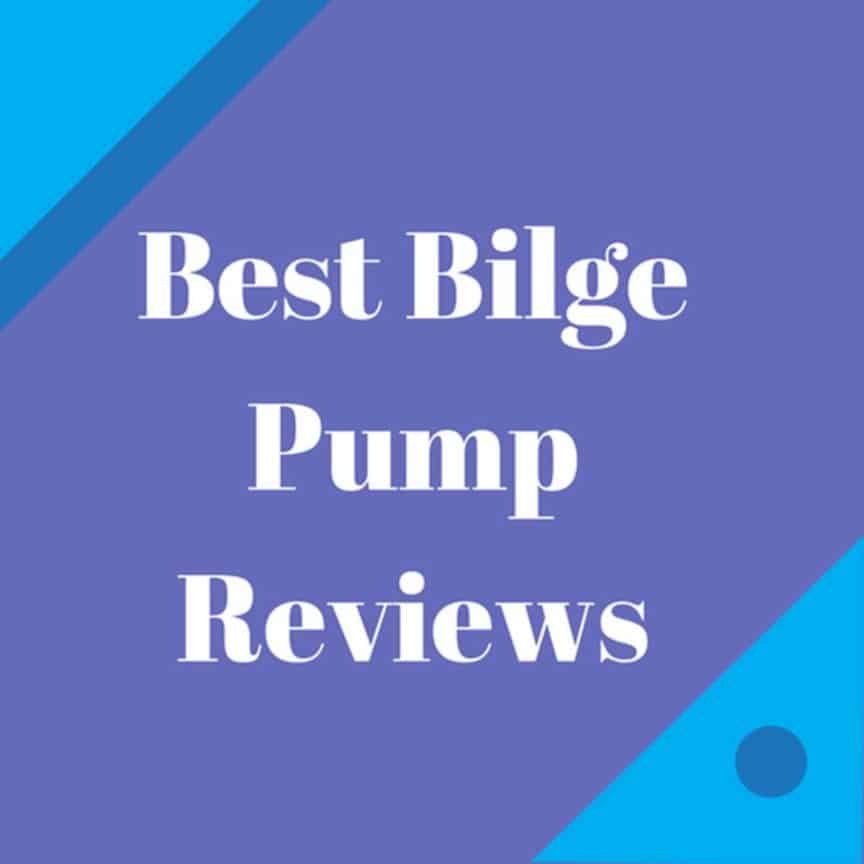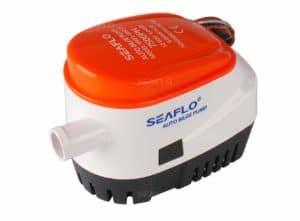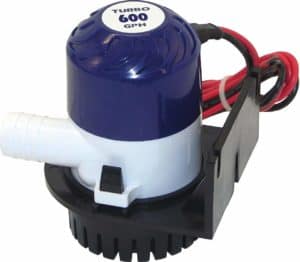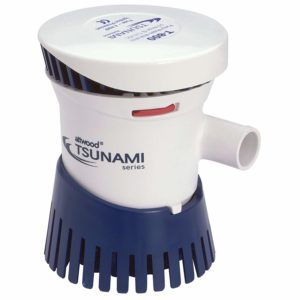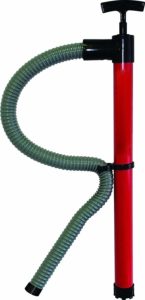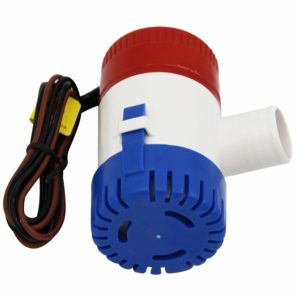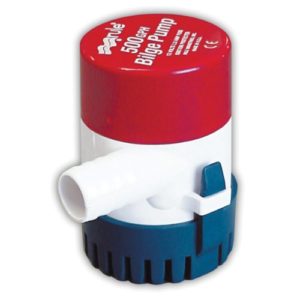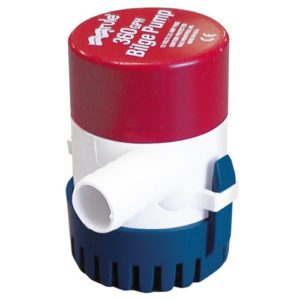Most people don’t think about bilge pumps when they are trying to get their boats maintained. Having the best bilge pump for your boat is a necessity for keeping it safe. Why? Because the bilge pump is one of the most important items your boat needs when it comes to keeping things maintained the right way.
The main goal of a bilge pump is to clear out water from the bilge area of your boat. This is vital for ensuring that your boat can stay afloat. It is even more important in an emergency when you are trying to reduce the amount of water your boat might start to take on.
The good news is that many companies today are making bilge pumps for your use. These include pumps that can handle large amounts of weight at a time. But no matter what pump you need, you must look carefully at how well this can work and how it can be used. You must have the best bilge pump for your vessel so you will stay safe.
This listing of some of the top models on the market includes many choices that can fit in perfectly with your demands for keeping water out of your boat.
Our choice for the bilge pump is Seaflo Automatic Submersible Boat Bilge Water Pump. You will learn here about how individual automatic and manual pumps alike work and how well they can handle the water that gets into your boat. You can also see in this guide how well a hose port can work and what you can do to make the most of it.
Best Bilge Pump In 2021 | Comparisons
| Bilge Pump | Size (GPH) | Output Hose Port (inches) |
Shoreline Marine Bilge Pump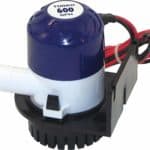 |
600, 800 or 1100 | 3/4 Today’s Price On Amazon |
| Seaflo Automatic Submersible Boat Bilge Water Pump  |
750 | 3/4 Today’s Price On Amazon |
Attwood Tsunami Manual Bilge pump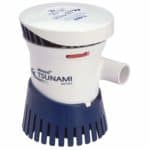 |
500, 800 and 1200 | 1 Today’s Price On Amazon |
| SeaSense Hand Bilge Pump Hose |
n/a | 1 Today’s Price On Amazon |
| Seattle Sports Paddlers Bilge Pump |
n/a | 1 Today’s Price On Amazon |
Aurelio Tech 1100GPH Pump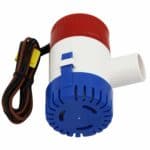 |
1100 | 1 Today’s Price On Amazon |
Amarine-made Automatic Submersible Boat Bilge Water Pump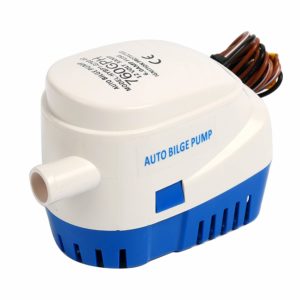 |
760 | 3/4 Today’s Price On Amazon |
Rule 25D Submersible Bilge Pump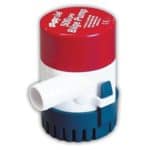 |
500 | 3/4 Today’s Price On Amazon |
Rule 24 Submersible Bilge Pump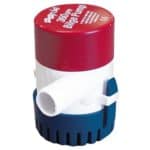 |
360 | 3/4 Today’s Price On Amazon |
Features Of Top 9 Bilge Pumps

Best Bilge Pump Reviews
Note: A majority of the products to review here are automatic pumps that handle large amounts of water at a time. There are a few manual options to review here for the sake of comparison. Be sure to review both types to identify what might be more appropriate for your particular situation. Here are our nine selected bilge pumps:
- Shoreline Marine Bilge Pump
- Seaflo Automatic Submersible Boat Bilge Water Pump
- Attwood Tsunami Manual Bilge Pump
- SeaSense Hand Bilge Pump Hose
- Seattle Sports Paddlers Bilge Pump
- Aurelio Tech 1100GPH Pump
- Amarine-made Automatic Submersible Boat Bilge Water Pump
- Rule 25D Submersible Bilge Pump
- Rule 24 Submersible Bilge Pump
1. Shoreline Marine Bilge Pump
This first option for the bilge pump for use is a Shoreline Marine unit available in 600, 800, and 1100 GPH sizes. It uses a standard ¾-inch output hose port and can mount itself to most units. It has a simple installation setup as well, thus keeping your boat protected and safe from excess water that it might take in. You can use this with most hoses to move water out from the bottom part of your boat with ease provided it is installed appropriately and the water has a clear path out.
Pros
- Comes with mounting hardware for easy installation
- Simple design moves water well
Cons
- Check the quality of your boat to see what size is right for you
- Might be rather noisy
2. Seaflo Automatic Submersible Boat Bilge Water Pump
This 750 GPM unit offers a float switch that is built into its body. You do not have to get a separate switch ready to make this work for your needs. The unit will not use any power until the water level in the bilge area starts to rise. A reed sensor system helps with identifying what is happening in the boat. The automatic functionality of this pump allows it to quickly take out the water that starts to build up within your boat, thus ensuring everything is protected carefully.
Pros
- Stainless steel body keeps it intact
- Seals are very tight
- Can run dry and will not burn out
Cons
- Might experience false alarms that cause it to start running at random
- Tough to fit onto older boats
3. Attwood Tsunami Manual Bilge Pump
This choice from Attwood works in one of three sizes. It uses a motor core that can be opened and replaced as needed. This is a basic model that should work with most types of hoses that you can attach to it.
Pros
- Slim design
- A larger hose port ensures water can move out fast
- Works with most types of 1-inch hoses
- The versatile layout works for many types of boats
Cons
- Easy for its parts to get caught up in each other at times
- You might need to get at least two just to make it work on your boat
4. SeaSense Hand Bilge Pump Hose
This choice is a little different from the other bilge pump products in that it is a hand-powered model. This would require you to insert a pole that would reach into the bilge area. As you use the plunger feature on the top, it will move water out through the flexible hose. This is ideal for use if you need a backup model. You do not have to drill anything into your boat either; you have to stick the pump and hose into the proper bilge region and then start pumping.
The unit comes with a tube cap that keeps the tube sealed while forcing the water out of your outlet. It also keeps the plunger shaft intact and secure. The key is to keep the water moving properly without being at risk of possibly damaging your plunger washer.
Pros
- Simple interface with easy to use the handle
- The hose is very flexible
- Comes in a variety of sizes
Cons
- Not intended for use as a primary pump
- Requires extensive effort for use
5. Seattle Sports Paddlers Bilge Pump
This is another handheld pump that is very slim. It is only 12 ounces in weight and has a 1.75-inch diameter. At 21 inches in length, it is portable and yet will fit into even the tightest bilge area. The rubber handle is also easy to grip on.
Pros
- Perfect for use on a kayak
- The neon yellow color makes it easily visible
Cons
- Water can quickly splash out when it gets out of the output
6. Aurelio Tech 1100GPH Automatic Bilge Pump
This next option among the best bilge pump products is an automatic unit from Aurelio Tech. This works at 1100 GPH and is made with an ABS body. This offers a waterproof body while also working with a series of terminals and wire ends that are fully sealed and secured to keep from being bogged down by the water.
This uses a universal mounting setup that should work on most boats. The compact body is also properly sealed to ensure that there are no vibrations produced by the pump or any excess sounds coming out of it.
Pros
- The secure body does not vibrate much
- Strong layout with universal ports is easy to secure around the bilge area
Cons
- Electric wires can get jumbled
- The outside body needs to be cleaned on occasion
7. Amarine-made Automatic Submersible Boat Bilge Water Pump
This next option can work with 760 gallons per hour. It uses a float switch inside its body with no outside switch needed. A reed sensor system is added to ensure this works automatically. This identifies water in a spot and starts working when it notices an excess amount provided that the unit is installed in the right place in the bilge area.
The stainless steel shaft also works quickly and will stay intact for years to come. The stainless steel material will resist corrosion and rust.
Pros
- Automatic material works quickly when it notices water
- Simple electric wiring material is easy to control
Cons
- Not as strong as many other comparable options
- Difficult to clean out
8. Rule 25D Submersible Bilge Pump
You can get this Rule 25D pump in one of two forms. You can get it with a standard body that can handle a 12-volt battery or with a series of six-foot leads that make it easier for the unit to link up to that said battery.
The pump uses a ¾-inch hose output and operates silently. The sturdy casing ensures that the pump will not generate lots of vibrations while in use. This model can handle 500 GPM and is designed with smaller boats in mind. A stainless steel shaft is also added to keep the unit working fast while not rusting or suffering from lots of outside damage over time.
If you need a more powerful and higher capacity bilge pump, you can go through our complete review of Rule 2000 GPH bilge pump.
Pros
- The sturdy body keeps working for hours at a time
- Comes with a three-year warranty
- Handles various water conditions
Cons
- Intended for smaller vessels
- You would have to get the leads added separately or pay extra for a model that has them
9. Rule 24 Submersible Bilge Pump
The rule also makes this final choice for the bilge pump you can order. This model has a ¾-inch outlet and handles 360 GPH. It is made with smaller boats that will go through surfaces that are not overly rough.
Pros
- Works in most weather conditions
- Designed for all types of water
Cons
- Intended for smaller boats
Buying Guide For The Best Bilge Pump
As you look for a bilge pump, you will have to take a careful review of all the features that come with it. A good bilge pump should be easy to handle and not require too much effort when trying to make it operate well enough. Take a look at these points when finding one of the best bilge pumps you can utilize.
Flow Rate
The flow rate is the most important measurement to see when you are selecting the proper bilge pump. The flow rate refers to the amount of water that a pump can handle within a given period. This is measured based on the GPH or gallons per hour that the pump can handle.
You need a model that offers enough support for getting as much water out as possible based on the size of your boat. Refer to the FAQ section for additional information on what you can get out of your boat.
But even with the official GPH total being listed on the unit, you would have to watch for how well the GPH works based on the hose you are using. Think carefully about the diameter of the hose plus the height that you have to move the water out by from the pump to outside the boat when thinking about the flow rate. The odds are the actual GPH on your pump will be lower than whatever you might have read on the unit itself.
Manual or Automatic?
You can come across both manual and automatic bilge pumps when finding something suitable for your needs. A manual pump will move water quickly to get water out by using physical force. With this, you would have to pump something up and down to get the water in a spot out.
But an automatic pump can operate with a switch that keeps the water flowing out carefully and quickly. It will work automatically when it senses water. A good rule of thumb is to have a manual pump to go alongside an automatic pump as a backup if any electric system inside your boat starts to fail.
Nozzle (for manual pumps)
You would have to watch for how the nozzle on any manual pump you wish to use is organized. An appropriate nozzle that can spread out by a few feet is vital for getting the water you pump out as far away from the boat as possible. Not all manual pumps will come with hoses that can connect to a nozzle.
Nozzle (for an automatic pump)
The nozzle is another point for an automatic pump that can handle a larger amount of water at a time. You would have to find a stronger nozzle that can move out from the bilge pump and into the water outside of the boat. The nozzle would have to be rigid and might need to be bolted into a spot within the hull to keep it intact. The nozzle would have to handle the intense flow that may be generated as well.
Not all automatic bilge pumps will come with their own nozzles though. Fortunately, the output holes on pumps help you get an idea of what you would utilize.
Switch Features
The switch inside your automatic bilge pump is vital to its operation. A switch can include an automatic setup that identifies when water is in a spot. When the sensors identify water, the bilge pump will start working.
An electric switch may also help with identifying water. It can compare water with fuel or other items around the boat, thus ensuring it does not spill any fuel or other items that your boat needs.
All of these switches are valuable, but you would have to ensure your pumps are linked to your body’s electric system. This includes having the right connections and marine batteries intact.
You can also find some options that come with manual switches if desired. But while this can provide you with an extra bit of control over how the switch works, you must still look at how well the unit works in any case. A manual switch would link up to an area around the cabin, but it would need some extra wiring and connections for it to work to its best potential.
Wiring
The wiring on your bilge pump is vital to see. Bilge pumps will use an appropriate wiring setup based on the GPH total it can handle. A 16-gauge wire works when the pump can handle less than 800 gallons, for instance. A 14-gauge wire can work for something a little larger.
Any industrial pump that handles 4000 GPH should work with a 10-gauge wire. Such a wire will be sturdy enough to handle the intense electric current that must go through the get the pump to work.
Be aware of how the wiring works regardless of the model you have. Not all of the good quality bilge pumps come with their own electric wires. You might have to add your own wires to a pump through some connections. The wires that would be used regardless of the situation should be sturdy and capable of linking to a 12-volt battery or whatever the power source the pump requires might be. This is applicable specifically to automatic pumps.
You must especially watch for the wiring based on how well it can link to a 12-volt battery. The key is to allow the unit to keep on working without draining more power from the battery than what one might normally handle at a moment.
Output Hose
The output or discharge hose attached to your bilge pump is responsible for allowing the water to move out of the bilge area. The hose should be smooth as it goes from the pump to the hull. For a manual pump, this will work with a flexible body that carries water away from the main body of the boat if used well enough.
The output hose should have a good diameter. In most cases, the diameter will be around an inch in size or slightly less or greater than that number. Be aware of how well this hose can handle the water that you are aiming to pump out so you have something that works appropriately.
Motor Housing and Features
The motor inside your pump needs to come with a good body that can handle all the water that goes through it. Stainless steel materials are often used as they will not corrode or rust over time. These work well in many water conditions in particular.
But regardless of what the motor is made of, proper housing is needed to keep it safe. The housing should be capable of handling all the vibrations and stresses that will come onto the body of the motor. Be aware of how well this might work when seeing something that does well with your use.
Frequently Asked Questions
Why would the bilge area of the boat keep taking in all that water?
Although today’s boats are made to be sturdy without risking serious problems, you would still have to watch for how well the bilge area can handle water. The sealants and other features around a boat can only handle so much water because it can start to take it in. Having a bilge pump will help to get rid of all that extra water that gets into the way, thus keeping leakage and other serious threats from being an issue while using the boat.
The amount of water that the bilge area can take in overtime will vary based on the type of boat you have and how the conditions in an area might be. Sometimes the physical quality of the boat itself will influence how well the bilge area can handle all that water. Whatever the case might be, you would have to watch for how well the bilge operates so you know what to do with getting a quality pump added.
Why is a bilge pump so important to have in the first place?
You will require a bilge pump when you are looking to protect your boat. A bilge pump is needed for keeping water from flooding your engine and electric system.
The bilge is a small part of the boat that could be overwhelmed quickly if too much water gets into the boat. Having a bilge pump ensures that this area will stay protected while seeing that the electric features in your boat will not be at risk of harm.
How many bilge pumps do you need on your boat?
The number of bilge pumps you will require will vary based on the length of your boat. A boat that is around 20 to 25 feet in length or less will get by with two pumps. A boat up to 40 feet long could use a third pump. Boats that are longer than that will need at least four.
Adding extra pumps into your boat works to ensure that your boat will not lose its ability to pump out water. This can also work in cases where you have a large amount of water that has to get out of your boat and very little time to handle it with.
How much capacity should you have for your boat?
A good rule of thumb is to have a capacity of 500 GPM per pump for a boat up to 18 feet in length. Increase that total by about 200 or 300 GPM for every extra five feet that you add onto the boat. A 28-foot boat would need around 1200 GPM in power support to get a pump to work accordingly.
Can your bilge pump work with fresh and salt water alike?
A bilge pump will do well with all kinds of water. But you should at least look at how well the pump can manage each option and that the housing on your unit is strong enough to manage the rough sensations produced by salt water.
There is a risk that salt water might cause some kind of damage to your bilge pump if its motor and other features are exposed. Watch for how any wires or poles you use are impacted by salt water as well. The goal is to keep everything running smoothly even if you are in a salt water space where it might be tough to get the help you need from a pump.
Is a pump likely to fail?
The odds of a bilge pump failing are nowhere near as great as the odds of an electric system on your boat failing. The electrical system that the boat works with might fail after a while. As a result, you should use multiple pumps on your boat to reduce the risk of pumps not working due to the inability of your boat to pump water out of a spot.
You should still review the pumps in your boat regularly to see how well they are operating. Look to see if there are any obstructions or blockages inside your pumps. Make sure those issues are cleared out soon in the event you ever come across these threats.
If you ever go for a used boat check the bilge pump’s condition.
How much weight does a typical bilge pump weigh?
An average bilge pump should weigh about a pound or two. This is good enough to keep working without adding lots of weight onto the boat.
Where would one of these bilge pumps be installed for the best results?
The key to installing a bilge pump is to get it around the middle part of your ship’s hull. Get it added at some point below the waterline, but always make sure the hose you add onto your boat will stick out above the waterline.
Adding a second pump near the first one may work as well provided that one uses a separate hose and possibly allows water to come out from the other end of the boat. The key is to allow the water to move out gently without added problems over how it is flowing.
One good idea is to keep a pump in the middle part of the boat to at least add a bit of extra coverage around the entire boat. Doing so makes it easier for you to get the boat reviewed well enough.
What type of hose would work best for your bilge removal needs?
Watch for the hose that you would attach to your bilge pump. Sometimes a pump might come with its own accompanying hose, but it would be better for you to get a smoothbore hose added. This works as a sanitation hose. It is made with reinforced vinyl material and is much stronger than basic bilge pump hoses. The risk of the flow being blocked as water moves out will be minimal when this is used.
A metallic hose could also work provided it is bolted down inside the boat well enough. This could prove to be more work than what you can afford to handle though.
Are all bilge pumps submersible?
Just about all bilge pumps should be fully submersible. After all, they need to work accordingly to get all that water out. But you should still look at how well any pump you want to get is built and that it has a secure casing that will not wear out or come apart after a while.
How much power does a bilge pump need for it to work properly?
The bilge pump will require access to a 12-volt battery in most cases.
What does it cost to get a bilge pump?
You can find a bilge pump for about $20 to $50 on the market. Manual pumps typically cost less money to get. The more powerful models that can handle more water at a time will also cost more to get. Be aware of your pumping needs when figuring out your budget for getting your pumps ready for use.
Will you have to install any new holes around the body of your boat to get the pump to work well?
The odds are you would have to get a new hole on the side of the boat to get the water from the pump to move out of the boat. Sometimes a boat will already come with one of these holes.
This should guide you towards managing the installation process the right way. But even at that juncture, you might have to install a new hole if you need more than one pump or you find an existing hole is not working as well as it should.
Conclusion
The bilge is a spot that can take on water rather easily as you move along in the water. You have to get rid of the water in the bilge to not only keep the boat from dragging but to also protect any electric components inside of it. Having the best bilge pump available for your use is vital to your success while out on the water.
Be aware of what you will get out of the bilge pump you order. Look at how it works and how much capacity it can handle, not to mention how it will move water out from your boat. By using the right bilge pump, you will keep your boat safe and comfortable without putting it through more risks than what the vessel can handle. A recommendation for boating safety should not be neglected.
Good luck with your search for finding the appropriate bilge pump that you can order. You will be impressed with how well this can work if managed right.

